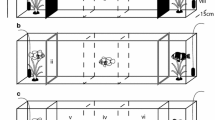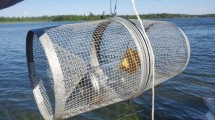Abstract
The carcasses of semelparous Pacific salmon (Oncorhynchus spp.) provide nutrients that enter aquatic ecosystems by various pathways, including direct consumption of tissue by fishes. Salmonids and other species frequently eat eggs and other tissues from dead salmon but the roles of vision and olfaction are unclear, as is the relative attraction to different tissues. Accordingly, we conducted a series of in situ experiments using minnow traps in two natural streams in Alaska to test the relative roles of chemosensory and visual cues in attraction of fishes to eggs from adult Pacific salmon, and then compared catch rates of traps baited with eggs, muscle, liver, and testis. Experiments indicated that chemical traces were necessary and sufficient to attract juvenile Dolly Varden (Salvelinus malma), coho salmon (Oncorhynchus kisutch), and sculpins (Cottus spp.) into traps. Combining both sites, 70 salmonids and 19 sculpins were trapped using visual and chemical cues, and 53 and 21, respectively, for traps with only chemical cues. Traps with only the sight of eggs caught no salmonids and only 5 sculpins, comparable to empty control traps. In addition, eggs were markedly more attractive than the other tissues, trapping 68 % of the salmonids and 69 % of the sculpins, compared to 14 % and 15 % for muscle tissue, 12 % and 11 % for liver, and 6 % and 5 % for the testis. Visual cues undoubtedly play a role in egg consumption in streams, but these experiments indicated a very important role of chemical traces in attracting fish to the vicinity of the eggs, and selective attraction of eggs over other salmon tissues.
Similar content being viewed by others
References
Armstrong JB, Schindler DE, Omori KL, Ruff CP, Quinn TP (2010) Thermal heterogeneity mediates the effects of pulsed subsidies across a landscape. Ecology 91:1445–1454
Aymes J-C, Larrieu M, Tentelier C, Labonne J (2010) Occurrence and variation of egg cannibalism in brown trout Salmo trutta. Naturwissenschaften 97:435–439
Bilby RE, Fransen BR, Bisson PA, Walter JK (1998) Responses of juvenile coho salmon (Oncorhynchus kisutch) and steelhead (Oncorhynchus mykiss) to the addition of salmon carcasses to two streams in southwestern Washington, U.S.A. Can J Fish Aquat Sci 55:1909–1918
Bryant MD (2000) Estimating fish populations by removal methods with minnow traps in southeast Alaska streams. N Amer J Fish Manag 20:923–930
Denton KP, Rich HB Jr, Quinn TP (2009) Diet, movement, and growth of Dolly Varden in response to sockeye salmon subsidies. Trans Amer Fish Soc 138:1207–1219
Denton KP, Rich HB Jr, Moore JW, Quinn TP (2010) The utilization of a Pacific salmon Oncorhynchus nerka subsidy by three populations of charr Salvelinus spp. J Fish Biol 77:1006–1023
Dittman AH, Brown GS, Foote CJ (1998) The role of chemoreception in salmon-egg predation by coastrange (Cottus aleuticus) and slimy (C. cognatus) sculpins in Iliamna Lake, Alaska. Can J Zool 76:406–413
Eastman DE (1996) Response of freshwater fish communities to spawning sockeye salmon (Oncorhynchus nerka). Master’s thesis, University of Washington, Seattle, WA
Ellings CS (2003) The influence of spawning Pacific salmon (Oncorhynchus spp.) on the stable isotope composition, feeding behavior, and caloric intake of coastal cutthroat trout (O. clarki clarki). Master’s thesis, Evergreen State College, Olympia, WA
Ferrari MCO, Chivers DP, Wisenden BD (2010) Chemical ecology of predator–prey interactions in aquatic ecosystems: a review and prospectus. Can J Zool 88:698–724
Finelli CM, Pentcheff ND, Zimmer RK, Wethey DS (2000) Physical constraints on ecological processes: a field test of odor-mediated foraging. Ecology 81:784–797
Fitzsimons J, Williston B, Williston G, Bravener G, Jonas JL, Claramunt RM, Marsden JE, Ellrott BJ (2006) Laboratory estimates of salmonine egg predation by round gobies (Neogobius melanostomus), sculpins (Cottus cognatus and C. bairdi), and crayfish (Orconectes propinquus). J Great Lakes Res 32:227–241
Foote CJ, Brown GS (1998) Ecological relationship between freshwater sculpins (genus Cottus) and beach-spawning sockeye salmon (Oncorhynchus nerka) in Iliamna Lake, Alaska. Can J Fish Aquat Sci 55:1524–1533
Garner SR, Heath JW, Neff BD (2009) Egg consumption in mature Pacific salmon (Oncorhynchus spp.). Can J Fish Aquat Sci 66:1546–1553
Gende SM, Edwards RT, Wilson MF, Wipfli MS (2002) Pacific salmon in aquatic and terrestrial ecosystems. BioScience 52:917–928
Gende SM, Quinn TP, Willson MF, Heintz R, Scott TM (2004) Magnitude and fate of salmon-derived nutrients and energy in a coastal stream ecosystem. J Freshwater Ecol 19:149–160
Greeley JR (1932) The spawning habits of brook, brown and rainbow trout, and the problem of egg predators. Trans Am Fish Soc 62:239–248
Hara TJ (2006) Feeding behaviour in some teleosts is triggered by single amino acids primarily through olfaction. J Fish Biol 68:810–825
Hendry AP, Berg OK (1999) Secondary sexual characters, energy use, senescence, and the cost of reproduction in sockeye salmon. Can J Zool 77:1663–1675
Johnson JH, Ringler NH (1979) Predation on Pacific salmon eggs by salmonids in a tributary of Lake Ontario. J Great Lakes Res 5:177–181
Johnson JH, Nack CC, Chalupnicki MA (2009) Predation by fallfish (Semotilus corporalis) on Pacific salmon eggs in the Salmon River. New York J Great Lakes Res 35:630–633
Kleerekoper H (1969) Olfaction in fishes. Indiana University Press, Bloomington
Mazur MM, Beauchamp DA (2003) A comparison of visual prey detection among species of piscivorous salmonids: effects of light and low turbidities. Envir Biol Fish 67:397–405
Meka JM, Margraf FJ (2007) Using a bioenergetic model to assess growth reduction from catch-and-release fishing and hooking injury in rainbow trout, Oncorhynchus mykiss. Fish Manag Ecol 14:131–139
Mirza RS, Chivers DP (2002) Attraction of slimy sculpins to chemical cues of brook charr eggs. J Fish Biol 61:532–539
Moore JW, Schindler DE, Ruff CP (2008) Habitat saturation drives thresholds in stream subsidies. Ecology 89:306–312
Naiman RJ, Bilby RE, Schindler DE, Helfield JM (2002) Pacific salmon, nutrients, and the dynamics of freshwater and riparian ecosystems. Ecosystems 5:399–417
Orians GH, Jantzen DH (1974) Why are embryos so tasty? Amer Nat 108:581–592
Pavlov DS, Kasumyan AO (1990) Sensory principles of the feeding behavior of fishes. J Ichthyol 30:77–93
Portt CB, Coker GA, Ming DL, Randall RG (2006) A review of fish sampling methods commonly used in Canadian freshwater habitats. Can Tech Rep Fish Aquat Sci 2604:56
Ruff CP, Schindler DE, Armstrong JB, Bentley K, Brooks GT, Holtgrieve, GW, McGlauflin MT, Torgersen CE, Seeb JE (2011). Temperature-associated population diversity in salmon confers benefits to mobile consumers. Ecology 92:2073–2084
Scheuerell MD, Moore JW, Schindler DE, Harvey CJ (2007) Varying effects of anadromous sockeye salmon on the trophic ecology of two species of resident salmonids in southwest Alaska. Freshwater Biol 52:1944–1956
Weissburg MJ, Zimmer-Faust RK (1993) Life and death in moving fluids: hydrodynamic effects on chemosensory-mediated predation. Ecology 74:1428–1443
Willson MF, Halupka KC (1995) Anadromous fish as keystone species in vertebrate communities. Cons Biol 9:489–497
Acknowledgments
We thank Conrad Gowell, Jennifer Griffiths, and Lindsey Cipiela for assistance with the Chignik River trials, Brian Quinn, and the students in the Aquatic Ecological Research in Alaska class for the Whitefish Creek trials, and Darran May for assistance preparing sampling supplies. Comments by Ray Hilborn and Daniel Schindler on earlier versions of the text are appreciated.
Author information
Authors and Affiliations
Corresponding author
Rights and permissions
About this article
Cite this article
Quinn, T.P., Dittman, A.H., Barrett, H. et al. Chemosensory responses of juvenile Coho salmon, Oncorhynchus kisutch, Dolly Varden, Salvelinus malma, and sculpins (Cottus spp.) to eggs and other tissues from adult Pacific salmon. Environ Biol Fish 95, 301–307 (2012). https://doi.org/10.1007/s10641-012-9996-2
Received:
Accepted:
Published:
Issue Date:
DOI: https://doi.org/10.1007/s10641-012-9996-2




